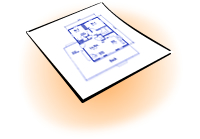
Looked at as a whole, designing and building a bathroom is a daunting task. Provided that you approach it from the right direction and manage it properly though, it doesn't need to involve any stress, and can be tremendously rewarding. The key to a stress-free bathroom build is to know what's involved, and to have a clear idea of what you want before you begin.
Choose a location
If you’re deciding where to put a bathroom in a new home, choose carefully. It should be close to other rooms where water's used (kitchen and laundry), and not too far from the bedrooms. Note which way doors will open and be exact in your measurements.
Decide what you're willing to spend
Set a realistic budget, and then stick to it. Decide which parts you can and can't compromise on, and do your research to come up with alternatives. You’ll need to identify what you want out of your bathroom and who will be using it. Will you need a bathtub? Can you afford under-floor heating?
Plan a basic layout
Once you’ve worked out how much you’re willing to part with and what you want from your bathroom, it’s time to decide what you really need in your bathroom, and how it'll be laid out. This will be determined by what you're going to use the bathroom for, who's using it, whether they'll use it at the same time, and how much space you have. If you're on a tight budget, you may opt not to have a separate bathtub and shower stall. If you only have limited space, you may not want a bathtub at all.
Settle on a style
Deciding on a style is where a lot of people come unstuck and budgets begin to spiral out of control. Showrooms and catalogues are designed to entice, and it’s very easy to get carried away with trendy, expensive fittings and fixtures. Matching the design of the room thematically with the rest of the house can also be difficult. There are a staggering amount of styles for bathrooms, and visualising them all working harmoniously is not always easy.
This is where engaging a bathroom designer can be a good idea. It might cost extra, but a designer can save you money and headaches in many other areas. Any designer worth their salt will be able to show you a folio of their previous work, and will be able to offer a variety of levels of involvement, from basic design consultation to managing the entire project. They will also have good connections with suppliers and tradespeople, which can help you save money in other areas.
Eventually, you will make decisions on what materials, fittings and surfaces you’re going to have. When you're deciding, take into account not just how things work and how they look, but also how easy they'll be to clean and maintain. Large mirrored vanity bench or cabinet surfaces, for instance, will show up fingerprints and grime far more obviously than light, textured, or matted surfaces. Likewise, intricate taps and wastes can be far harder to clean in and around.
Keep track of what’s been agreed upon so you can update the budget accordingly. Keep pictures and colour swatches together in a folder; this will help you visualise the finished product much better. Draw rough sketches if it helps.
Hire the right tradies
You will then need to start getting in the relevant tradespeople. Plumbers, electricians and builders will be primary among them, but you may also need to engage glaziers, cabinetmakers, painters and tilers. Look for bathroom specialists - they'll normally work in teams, and will be well versed with the entire process. When getting quotes, the more prepared you are, the better you’ll be able to explain your needs. Be upfront with your expectations on quality, time and budget and be prepared to negotiate for a fair price. Make sure you get a number of different quotes, but don’t take too long to decide; tradies are in high demand these days!
The build process
If you're renovating an existing bathroom, you'll also have to make alternative arrangements while the bathroom is being built. If you have a second bathroom this won't be a problem, but otherwise you may even have to make alternative living arrangements for a week or two. It's fine to oversee things, but try not to be too intrusive when the tradespeople are working. If something looks like it's not right, point it out immediately - this might save a lot of hassle further down the track. A good builder will normally consult you if there's any uncertainty anyway.
Be prepared for a bit of mess as well - renovating a bathroom can create a lot of waste, and you might need to hire a skip to get rid of the bits and pieces from your old bathroom.
Check the finished product
Once your bathroom's finished, resist the temptation to be completely swept away, and spend some time going over it with a fine-toothed comb. If you see any mistakes, tell the builder immediately and get them fixed as soon as possible. It’s you that will have to live with it so be thorough, and don’t be afraid to speak up about small things.
Looking for creative ideas? Check out our bathroom ideas gallery.







